Australia So Much to See


The Reynolds River Track to the south is open only in the dry season, requires a high clearance four wheel drive, and has shallow
water crossings and sandy patches.
The next drive was into Tjaynera (Sandy Creek) where there is a small NT Parks campground with hot showers provided. A pleasant
3.4 kilometre return walk basically follows the creek line to the small plunge pool from the Tjaynera Falls where I swam amongst the
fish and across to the waterfall, seeing some good sized bream.
Nearby is the Mount Tolmer tin mine which commenced in 1888 and was the first tin mine in the area. The sergeant family mined
this to supplement their farming activities. What appeared to be mica sparkled in the ground near the creek and near the mine
site.
A tragic story is told at the cattle yards. Dick Sargent and his brother Max were repairing the yards in 1939 following a fire,
and late Friday afternoon while Max had gone back to the main homestead at Stapleton Station for supplies, Dickís adze slipped and
partially severed his heel. He tried to staunch the bleeding with his belt. Aboriginal stockmen carried him to the homestead
and then rode to get Max, who rode through the night to get back to Blyth. With a stretcher made from canvas and saplings, they carried
Dick between two horses to the main homestead. The Finniss River was running about a mile wide and in crocodile territory. They swam diagonally downstream, dodging the treetops in the flooded river, taking Dick on a stretcher. Riding further with the stretcher
between the horses, they were met by Dick and Maxís Father Harry with the buckboard. Harry nursed Dick through the night and
then next day they took him to the train at Stapleton Station to go to hospital at Darwin. Sadly, Dick died the next day. Dick
was the fifth and Max the tenth child of the family of fourteen children.
First point of interest is Blyth Homestead, where there is a deeper water crossing to access the homestead. This simple dwelling
was built in 1928 by Harry Sargent and his teenage children as an outstation, and abandoned in the 1960s. It is a low roofed
one roomed hut constructed from cypress pine with a corrugated iron roof.
Following the track further south we passed some very tall cathedral termite mounds, at around four metres in height. On the
flat open plains were fan shaped magnetic termite mounds. The Reynolds River track continues south the cross the Reynolds River to
access the track into Surprise Creek Falls and campground, and continue on to meet the Daly River Road. Reaching the Reynolds River we
found the crossing was not deep, but the slope down to the river was steep and scarred with slide marks from tyres. We decided
it was not for our vehicle.
From the pool there is a well made boardwalk and falls viewing platform with a continuing walk to a large colony of fruit bats.
Calling into Wangi Falls for a welcome and cooling swim, we found a large parking area and picnic area and lots of people at the pool. Two sets of concrete steps give easy access into the big green plunge pool, most of which as shallow enough to stand in, so the water
had been warmed by the sun. There is a shallow area suitable for supervised young children. Two main streams and a number
of tiny seepages come down from high above into the plunge pool, with the water flowing fast into the creek near the larger of the
two falls. The tumbling water was cold. Investigating a small fernery near the second falls, I found warm water was seeping
in at the point and was it comfortable to sit and enjoy the warmth. Other seepage areas I felt were all cold.
Walking back along the creekline from Tjaynera Falls
Steps continue up a 400 metre climb through monsoon forest to a tree top lookout with views across the plains and walk over the top,
which we took on another day but I will keep together here. The NT Parks information sheet shows this walk as being 1.6 kilometres,
but if seemed around twice that distance. Reaching the top there is a boardwalk across the divided stream which forms the two
falls. There is no access to the edge of the falls and swimming is not permitted in these small streams. The path continues
on steps formed from natural rock back down to the plunge pool. After the climb and walk, a cooling swim was very welcome.
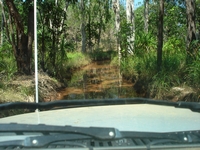
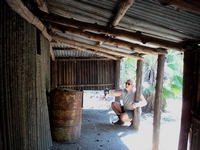
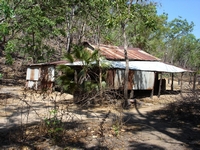
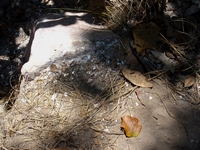

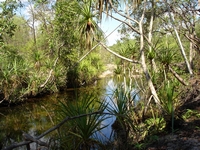
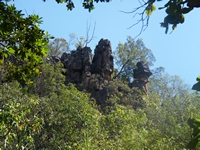
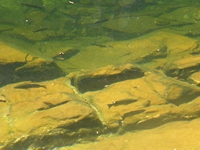
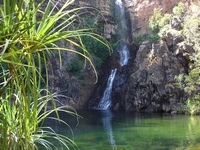
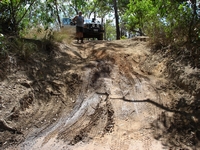
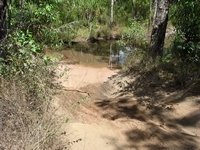
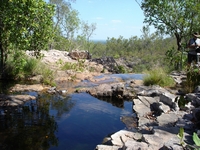
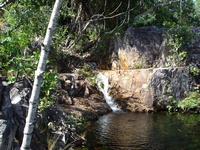
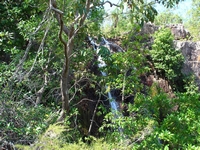
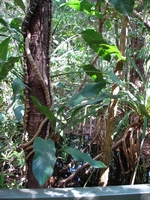
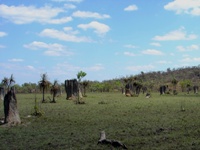
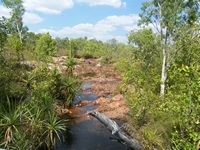
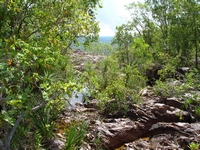
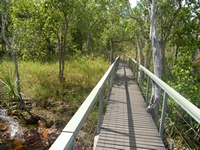
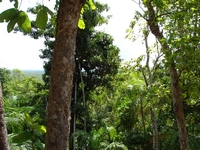
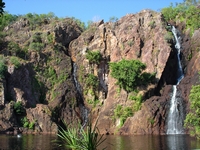
Greenant Creek walk is lovely, at first following a boardwalk through a rainforest lined creek. We hadnít seen epiphytes and
creepers twined around the trees and tall palms in the Northern Territory previously; it was a real rainforest experience. There
was a lovely sweet aroma. After the junction of the walk trail and the Tabletop Walk trail, the terrain changed to dry woodland
and stony hills. After crossing two hills, we reached Tjaetaba Falls, where a well constructed series of 46 steps goes down
to a viewing platform showing the top section of the falls behind leafy trees. There is no access to or swimming permitted below
the falls as it is a sacred site. A little further up the hill the trail ends at the top of the falls, where a series of cascades
flow through a shallow pool. With flat rocks, it was easy to access and gave an extensive view down the valley and into the
distance. The full walk is 2.7 kilometres return.
Like sentinals on the hills, sandstone pillars overlook Tjaynera Falls and plunge pool
Litchfield National Park - We visit Blyth Homestead ruins and Tjaynera (Sandy Creek)
Copyright (C) 2013 AustraliaSoMuchtoSee.com. All rights reserved






















